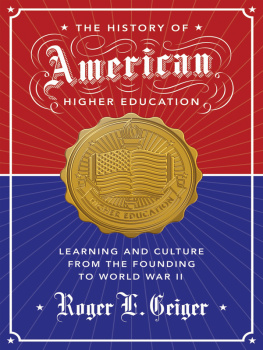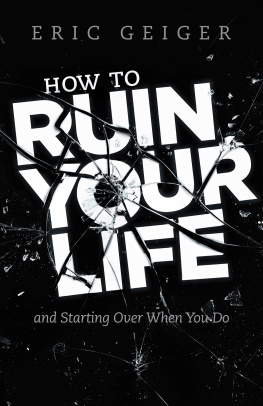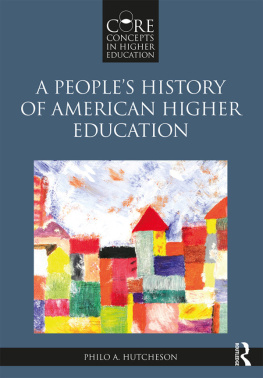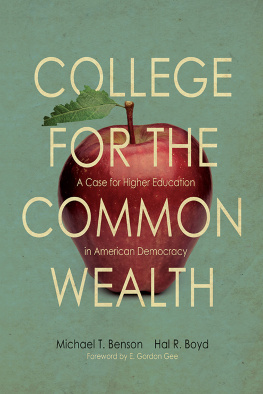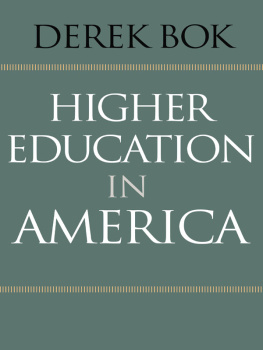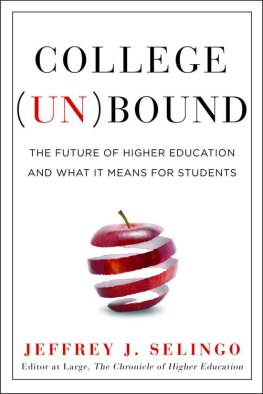

THE HISTORY OF
American
HIGHER EDUCATION
LEARNING AND CULTURE FROM THE FOUNDING TO WORLD WAR II
Roger L. Geiger
PRINCETON UNIVERSITY PRESS
Princeton & Oxford
Copyright 2015 by Princeton University Press
Published by Princeton University Press
41 William Street, Princeton, New Jersey 08540
In the United Kingdom: Princeton University Press
6 Oxford Street, Woodstock, Oxfordshire OX20 1TW
press.princeton.edu
Jacket design by Chris Ferrante
All Rights Reserved
Library of Congress Cataloging-in-Publication Data
Geiger, Roger L., 1943
The history of American higher education : learning and culture from the founding to world war ii / Roger L. Geiger.
pages cm.
Includes index.
ISBN 978-0-691-14939-4 (hardcover : alk. paper)
1. Education, HigherUnited StatesHistory. I. Title.
LA226.G395 2015
373.73dc23
2014007439
British Library Cataloging-in-Publication Data is available
This book has been composed in Garamond Premier Pro,
Avenir LT Std, and Blackletter 686
Printed on acid-free paper.
Printed in the United States of America
1 3 5 7 9 10 8 6 4 2
PREFACE
P RESIDENT BARACK OBAMA ANNOUNCED A GOAL OF having every American child obtain at least 1 year of higher education and having the nation produce 8 million additional college graduates by 2020. These objectives reflect the reality that going to college has both an economic and an iconic status in American society. Economically, the knowledge acquired in postsecondary education is described as a prerequisite for the growing jobs of the new economy and the clearest pathway into the middle class. As an icon, college has always symbolized the acquisition of advanced knowledge, access to careers more or less connected with such knowledge, and the assimilation of middle- or upper-middle-class culture. Knowledge, careers, and culture are and always have been not only the quintessential objectives of American higher education, but also the external factors that have shaped its development. For this study, they offer keys to delve more deeply into how American colleges and universities have been affected by currents in American societyand how they, in turn, have affected American life. This book is about how, why, and where Americans went to college over the course of three centuries and, particularly, about the institutions they attended to realize their aspirations.
The history of American higher education has been often told, but the richness and variety of this subject cannot be exhausted. This study is intended to enlarge and extend appreciation of that history from the beginnings of colonial colleges to the eve of World War II. Specifically, it seeks to explain how institutions of higher education changed over time in response to their contemporary contexts. The institutions that began in an isolated, provincial colonial society evolved into a system that served an incipient economic powerhouse by 1940. For the first two centuries, colleges existed in a preindustrial economy and a largely rural society. After the Civil War, they gradually adapted to an industrializing economy, an urbanizing society, and a global knowledge regime.
The colleges in colonial North America developed a single, powerful tradition in terms of mission, curriculum, governance, and student culture. Anchored in Reformed Protestantism, the colleges differed in distinctive and significant ways but were essentially variations on a single theme. This model was buffeted first by Independence and then by the post-1800 awakening of evangelical religion, but it endured nonetheless. The first significant aberration occurred with the formation of separate, largely autonomous professional schools, first for medicine and later for theology and law. The central collegiate tradition was redefined and reinforced by the Yale Reports of 1828, which supplied a unifying formula just as colleges began to proliferate. However, in the middle decades of the century, additional differences appeared as regional traditions of collegiate education diverged significantly in the Northeast, the South, and the trans-Appalachian West. Still, dramatically different paths would emerge following the Civil War.
In the last three decades of the nineteenth century, American higher education was broadened by three coeval and seemingly contradictory revolutions. The land grant movement sought to introduce the teaching of applied subjects and broaden social access. The academic revolution joined American scholars with international learning and organized them into disciplinary communities to better pursue the advancement of knowledge. Given the freedom to organize their own activities, students brought about a collegiate revolution that transformed campus life and at times overshadowed classroom studies.
Each of these areas evolved differently after 1900. A movement for liberal culture endeavored to enhance the positive features of campus social life and collegiate learning while repudiating the excesses of vocational curricula, academic specialization, and collegiate hedonism. The emergence of mass higher education considerably extended the possibilities for teaching applied subjects, but now in the cities more than the countryside and in new kinds of institutions. And American scholars and scientists, substantially aided by philanthropic foundations, emerged as intellectual leaders in basic scientific fields. The exuberance of the Roaring Twenties pulled American higher education in several directions, but the pall of the Great Depression had the opposite effectencouraging contraction, consolidation, and greater systemwide organization. By 1940 the systemic features of American higher education had crystalized in webs of associations for different types of institutions, academic fields, and types of personnel. Additional external organizations complemented core functions, particularly research. Although contemporaries could scarcely have realized it, an inchoate foundation for the postwar explosion of American higher education was largely in place.
By 1940 American higher education had achieved four results unmatched elsewhere in the world. It had preserved and entrenched a tradition of liberal education as a fundamental attribute of a college education for all students, not just an elite. It had augmented that tradition by incorporating applied and practical studies on the same collegiate and postgraduate levels. It thus produced the first system of mass higher education, largely through individual public and private institutions responding independently to student demand. It also developed the capacity to teach and advance academic subjects on the highest level, achieving world-leading status for American science.
focus on disparate developments largely after 1915, especially the formation of mass higher education, the maturation of research universities, and the state of higher education as of 1940. There are fifty sections in all; each has a particular story to relate and may be read independently to appreciate each of these subjects. Grouped in chapters, they reveal the multiple dimensions of American higher education at each point in time.
A work of this scope has no simple provenance. I began writing about the history of American higher education some 30 years ago while part of the Yale University Program on Nonprofit Organizations. In 1987 I joined the Higher Education Program at Pennsylvania State University, where I have taught the history of American higher education almost every year since, as well as more focused historical seminars.encouragement to new historians. It has given me an invaluable window onto the evolving historical literature and brought awareness of heretofore unsuspected topics.
Next page
